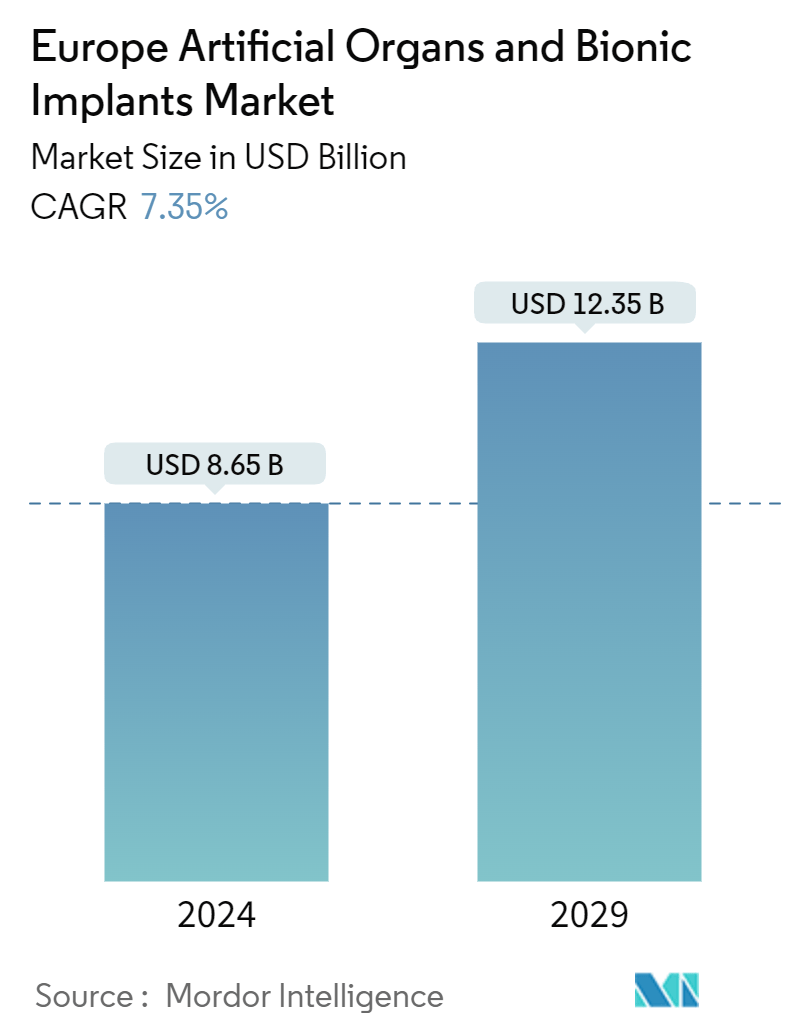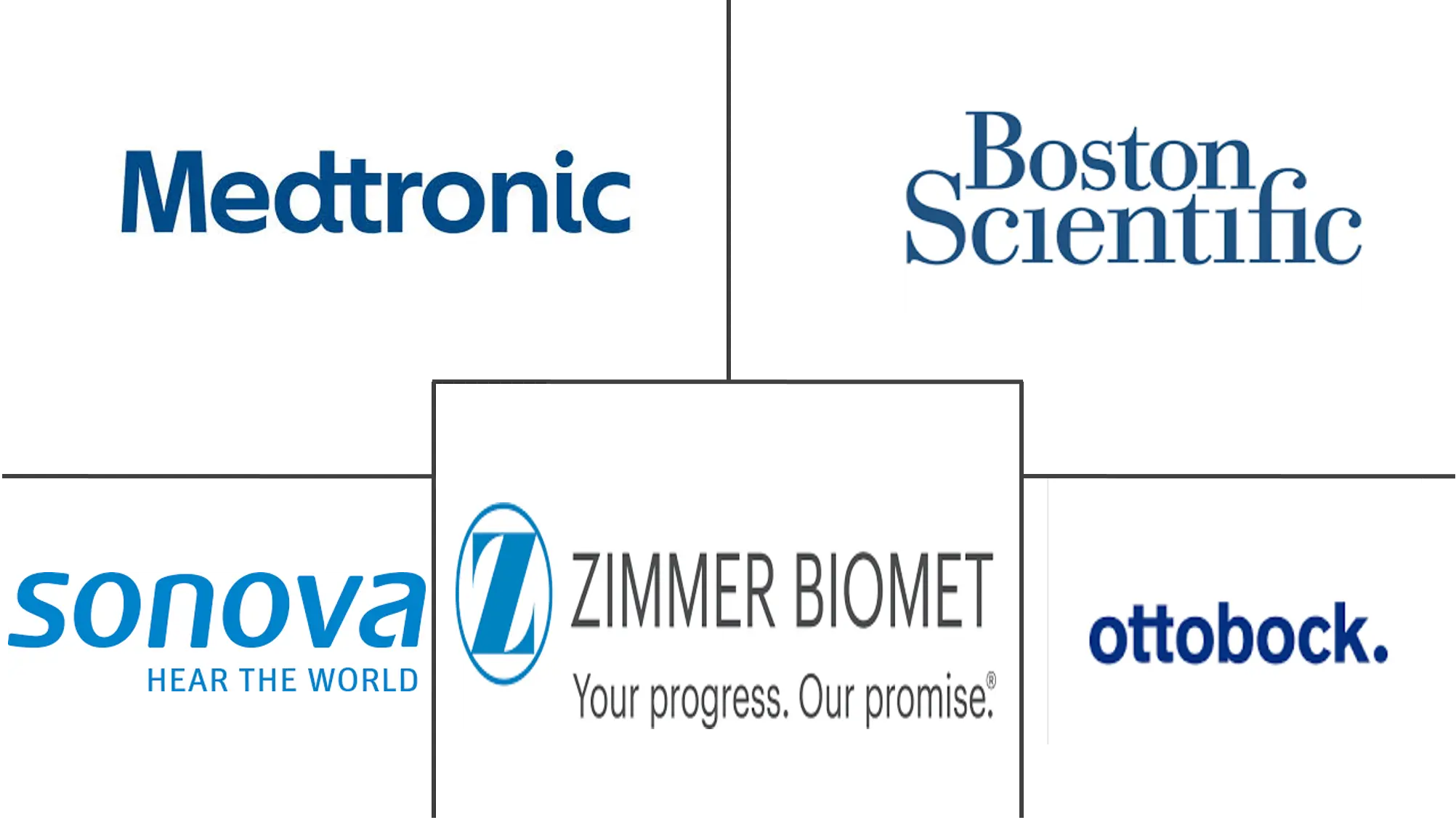Market Size of Europe Artificial Organs And Bionic Implants Industry

| Study Period | 2021 - 2029 |
| Base Year For Estimation | 2023 |
| Market Size (2024) | USD 8.65 Billion |
| Market Size (2029) | USD 12.35 Billion |
| CAGR (2024 - 2029) | 7.35 % |
| Market Concentration | Medium |
Major Players
*Disclaimer: Major Players sorted in no particular order |
Europe Artificial Organs and Bionic Implants Market Analysis
The Europe Artificial Organs And Bionic Implants Market size is estimated at USD 8.65 billion in 2024, and is expected to reach USD 12.35 billion by 2029, growing at a CAGR of 7.35% during the forecast period (2024-2029).
Factors such as the rising incidence of organ failures and disabilities, scarcity of donor organs, and technological advancements leading to enhanced applications are anticipated to drive market growth over the forecast period.
Major organs in a body, such as kidneys, liver, lungs, heart, central nervous system, and hematologic system, tend to fail among the target population. In Europe, the number of organ failures has been increasing consistently over the past few decades, but the number of organ donors remains few. This is creating demand for artificial organs in the region. For instance, a study published in the World Congress of Nephrology in April 2024 predicts a significant rise in advanced-stage chronic kidney disease cases (up to 59.3%) by 2032 across eight major countries, including the United Kingdom, Spain, Germany, and the Netherlands.
Furthermore, according to the same source, dialysis requirements are expected to surge by over 75%, increasing the economic and environmental burden. These factors are expected to create opportunities for adopting artificial organs and bionic implants, specifically artificial kidneys, to address the growing CKD crisis. Hence, the market is expected to grow considerably over the analysis period.
With a strong focus on research and development, coupled with growing demand due to an aging population and rising chronic diseases, this market is expected to experience significant growth in the coming years. For instance, according to the European Union in May 2023, the Breakthrough Technologies for an Implantable Artificial Kidney project funded with EUR 3.38 million (USD 3.63 million) by the Horizon European Innovation Council (EIC) in 2022 exemplified the ongoing research efforts toward a viable alternative. This indicates a strong focus on developing implantable artificial kidneys in Europe. Therefore, the European artificial organs and bionic implants market is poised for significant growth, driven by increasing funding for research.
In addition, the development of innovative dialysis technologies, including portable, wearable, and implantable artificial kidney systems, is set to transform this market, offering more effective and patient-friendly solutions. For instance, a study published in Nature Reviews Nephrology in June 2023 examined the integration of bioartificial kidneys (BAKs) with advanced membranes in the European market. This study emphasized BAKs, which merge artificial membranes with functional kidney cells and aim to restore critical biological functions that are typically managed through conventional dialysis. These functions include erythropoietin production, which is vital for red blood cell production, and vitamin D synthesis, which is essential for calcium metabolism and bone health. The study underscores the potential of these bioartificial systems to enhance patient outcomes by offering a more physiologically relevant alternative to traditional dialysis methods.
Thus, innovations such as portable and wearable artificial kidneys, advanced dialysis membranes, and bioartificial kidneys are poised to meet the growing demand, and they are anticipated to contribute to the growth of the artificial organs and bionic implants market over the forecast period. However, expensive procedures and fear of device malfunction and its consequences are expected to hinder the market's growth.
Europe Artificial Organs and Bionic Implants Industry Segmentation
As per the scope of the report, artificial organs are mechanical devices that can temporarily or permanently substitute for a body organ. These devices can replicate or augment the organ's natural function. Bionics refers to the replacement or improvement of body parts by mechanical means.
The European artificial organs and bionic implants market is segmented by type (artificial organs and bionics) and geography (Germany, the United Kingdom, France, Italy, Spain, and Rest of Europe). The report offers market sizes and forecasts in terms of value (USD) for all the above segments.
| By Product | |||||||
| |||||||
|
| Geography | |
| Germany | |
| United Kingdom | |
| France | |
| Italy | |
| Spain | |
| Rest of Europe |
Europe Artificial Organs And Bionic Implants Market Size Summary
The European artificial organs and bionic implants market is poised for significant growth, driven by an increasing incidence of organ failures and a scarcity of donor organs. The market is experiencing a surge in demand due to the rising prevalence of chronic conditions such as kidney and cardiovascular diseases, which have been exacerbated by demographic changes and the burden of non-communicable diseases. Technological advancements in artificial organs and bionic implants are enhancing their applications, further propelling market expansion. Despite the challenges posed by the COVID-19 pandemic, which initially disrupted transplantation procedures, the subsequent demand for organ replacements has created opportunities for market growth. The market is characterized by a moderate level of competition, with key players focusing on technological innovations and strategic collaborations to capture market share.
In the United Kingdom, the market is witnessing growth due to an increase in disabilities and accidental injuries requiring amputations, alongside a rising waiting list for organ transplants. The shortage of live organ donors and the high cost of healthcare for conditions like diabetes-related amputations are driving the demand for artificial organs. The market's expansion is supported by ongoing clinical trials and funding for developing advanced implantable solutions. Major companies such as Sonova, Medtronic, and Ottobock are actively involved in product development and business expansion to meet the growing demand. Recent developments, such as the launch of the POWER KNEE by Össur, highlight the focus on innovative solutions to enhance the quality of life for patients with limb differences.
Europe Artificial Organs And Bionic Implants Market Size - Table of Contents
-
1. MARKET DYNAMICS
-
1.1 Market Overview
-
1.2 Market Drivers
-
1.2.1 Increased Incidence of Disabilities, Organ Failures, and Scarcity of Donor Organs
-
1.2.2 Technological Advancements Leading to Enhanced Applications
-
-
1.3 Market Restraints
-
1.3.1 Expensive Procedures and Risk of Device Malfunction and its Consequences
-
-
1.4 Porter's Five Forces Analysis
-
1.4.1 Threat of New Entrants
-
1.4.2 Bargaining Power of Buyers/Consumers
-
1.4.3 Bargaining Power of Suppliers
-
1.4.4 Threat of Substitute Products
-
1.4.5 Intensity of Competitive Rivalry
-
-
-
2. MARKET SEGMENTATION (Market Size by Value - USD)
-
2.1 By Product
-
2.1.1 Artificial Organs
-
2.1.1.1 Artificial Heart
-
2.1.1.2 Artificial Kidney
-
2.1.1.3 Cochlear Implants
-
2.1.1.4 Other Artificial Organs
-
-
2.1.2 Bionics
-
2.1.2.1 Vision Bionics
-
2.1.2.2 Ear Bionics
-
2.1.2.3 Orthopedic Bionic
-
2.1.2.4 Cardiac Bionics
-
2.1.2.5 Other Bionic Types
-
-
-
2.2 Geography
-
2.2.1 Germany
-
2.2.2 United Kingdom
-
2.2.3 France
-
2.2.4 Italy
-
2.2.5 Spain
-
2.2.6 Rest of Europe
-
-
Europe Artificial Organs And Bionic Implants Market Size FAQs
How big is the Europe Artificial Organs And Bionic Implants Market?
The Europe Artificial Organs And Bionic Implants Market size is expected to reach USD 8.65 billion in 2024 and grow at a CAGR of 7.35% to reach USD 12.35 billion by 2029.
What is the current Europe Artificial Organs And Bionic Implants Market size?
In 2024, the Europe Artificial Organs And Bionic Implants Market size is expected to reach USD 8.65 billion.

